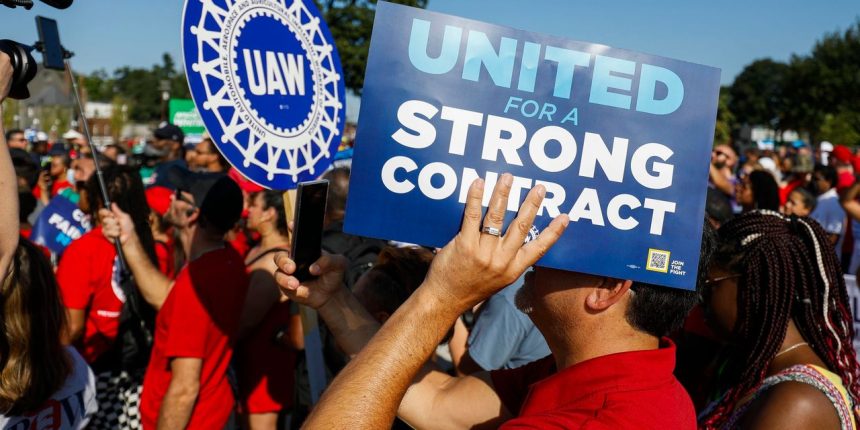“ Businesses have an opportunity to align their interests with that of their employees. ”
Call it the afterglow from a hot labor summer, but a key indicator of U.S. public support for unions recently notched a record high, with six in 10 Americans saying unions are good for the U.S. economy. Nearly the same number agreed a unionized workforce is helpful — not harmful — to their company’s success.
As a labor economist, I know that the public is onto something — and that the rise in U.S. labor activism and union formation is not an automatic threat to business interests and economic stability. Evidence shows that unionized workplaces are more productive and have a more stable workforce. Evidence also suggests labor unions can help correct market failures, reverse decades of income inequality, and support economic growth -– all forces that make the economy work better in ways that ultimately help business’s bottom line.
With renewed activism among workers and support for unions in both the public and private sectors, businesses have an opportunity to align their interests with that of their employees by taking a neutral stance on worker efforts to unionize. Doing so would not only mutually benefit employers and workers; it would also yield far-reaching gains for the broader economy.
But if unions are successful in representing worker interests, how does that help businesses?
One primary way that unions improve workplaces is by making them more productive. This is in part supported by unions giving employees ways to express their opinions about wages and benefits, and also to notify managers about inefficiencies within company policies and the production process without the threat of retaliation.
“Unionized workers are less likely to say they plan to quit their jobs.”
In addition to supporting productivity by allowing workers to have a voice in workplace decisions, unions may also improve business outcomes by helping firms hold on to tenured workers, who tend to be more productive. For example, research shows that unionized workers are less likely to say they plan to quit their jobs. When a worker is less likely to quit, it also increases the incentives for employers to invest in human capital and training.
In today’s competitive labor market, employers need to be able to promote job quality to maintain their workforce. Since unions must collectively vote on contracts that structure employee benefits, they are more likely to promote the interests of the average worker rather than the marginal worker. This does not necessarily mean that employers spend more, but that they spend on different priorities. That, in turn, may better reflect the average preferences of workers.
And given mounting concern over lack of competition in the economy, there has been increasing evidence how this leads to suboptimal wage and employment levels across the labor market. This phenomenon, known as “monopsony,” results from a variety of factors resulting from changing economic trends as well as inherent features of the labor market, including increasing corporate concentration, constraints that workers face moving around for jobs, and idiosyncratic preferences workers have for different job attributes. While competition policy such as antitrust enforcement offers partial solutions, evidence also suggests that unions are critical to ensuring competitive market outcomes.
“ Unionized workers earn on average 10.2% more than their nonunion counterparts.”
The positive benefits of unions for workers makes the nation’s overall economy better as well. It’s well established by economists that unions have a positive and significant effect on wages, which means they are succeeding at one of their primary functions. Over the course of a lifetime, the average male worker will earn $1.3 million more if they have consistently been a member of a union (This is true despite union workers on the whole retiring earlier.) Unionized workers earn on average 10.2% more than their nonunion counterparts, including when you control for education, experience, and occupation.
Unions can also help families build wealth, especially among Black, Latinx, Native American, and Asian-American households. Evidence points to unions being particularly beneficial for non-white workers and women workers, since these groups earn less without unions due to discrimination. Combined with their impact on raising incomes at the bottom of the distribution, these can lead to more economic activity, as workers with lower incomes spend a higher share of their earnings on consumption.
Along with higher productivity and decreased turnover, these broad economic impacts such as reducing income inequality and fostering consumer demand also ultimately benefit businesses, which can share in the gains of greater productivity and higher economic growth.
U.S. business leaders have an opportunity to enjoy these benefits by reimagining their relationship with unionized workforces: Rather than worker interests being viewed as inherently at odds with business interests, employers can align them through collective bargaining — a process that can kick off on a positive note by businesses voluntarily recognizing employees’ desire to form a union. It’s one step toward building stronger workplaces and company bottom lines — and a more robust economy.
Kate Bahn is the director of research of WorkRise, a research-to-action network hosted by the Urban Institute.
More: Big Three automakers need to step up for the workers who keep them profitable
Plus: Hollywood strikes have cost California $5 billion, analyst says
Read the full article here




